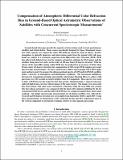Compensation of Atmospheric Differential Color Refraction Bias in Ground-Based Optical Astrometric Observations of Satellites with Concurrent Spectroscopic Measurements
Author(s)
Geykhman, Roman; Cahoy, Kerri
Download20191122_AIAA_SciTech.pdf (3.537Mb)
Open Access Policy
Open Access Policy
Creative Commons Attribution-Noncommercial-Share Alike
Terms of use
Metadata
Show full item recordAbstract
Ground-based telescopes provide the majority of observations used to track geostationary satellites and orbital debris. Many sensors specifically designed for Space Situational Awareness (SSA) operate over almost the entire 300--1100 nm sensitivity band of silicon. Earth's atmosphere is optically dispersive and observations made from the ground with wide passbands are subject to a systematic angle bias from differential color refraction (DCR). DCR bias affects both fiducial stars used to compute astrometric solutions for SSA images and the satellites being observed, and is on the order of 100 mas below 60 degrees elevation. With the release of the Gaia DR2 catalog, stellar DCR may be predicted to an accuracy of better than 20 mas above 20 degrees elevation but compensation of SSA target DCR requires per-target spectroscopic measurements. We have constructed a slitless spectrograph with COTS equipment and have used it to measure the silicon passband spectra of GPS and GLONASS satellites under a diversity of atmospheric and illumination conditions. The instrument multiplexes between two transmission gratings and suitable colored glass blocking filters to collect a full spectrum every 105 seconds on targets brighter than 12.5 magnitude. These spectra were used to infer a DCR bias for the target for that time period. Simultaneously, a separate telescope collected high frame-rate bare silicon images of the same targets. The images were processed into observations with color-aware astrometric reductions using the Gaia DR2 star catalog. The bare-silicon astrometry was compared with the final orbit solutions published by the International GNSS Service and the inferred DCR bias was compared against those observation residuals. 312 unique spectroscopic measurements on 14 distinct satellites were collected between 20 and 60 degrees elevation over seven nights from September 2018 to April 2019. Using these measurements, we demonstrate a 60\% reduction in bias and 30\% reduction in noise in the vertical component of astrometric residuals, relative to color-agnostic processing.
Date issued
2020-01Department
Lincoln Laboratory; Massachusetts Institute of Technology. Department of Aeronautics and AstronauticsJournal
AIAA Scitech 2020 Forum
Publisher
American Institute of Aeronautics and Astronautics
Citation
Geykhman, Roman O. and Kerri Cahoy. "Compensation of Atmospheric Differential Color Refraction Bias in Ground-Based Optical Astrometric Observations of Satellites with Concurrent Spectroscopic Measurements." AIAA Scitech 2020 Forum, January 2020, Orlando, Florida, American Institute of Aeronautics and Astronautics, January 2020. © 2020 MIT Lincoln Laboratory
Version: Author's final manuscript
ISBN
9781624105951